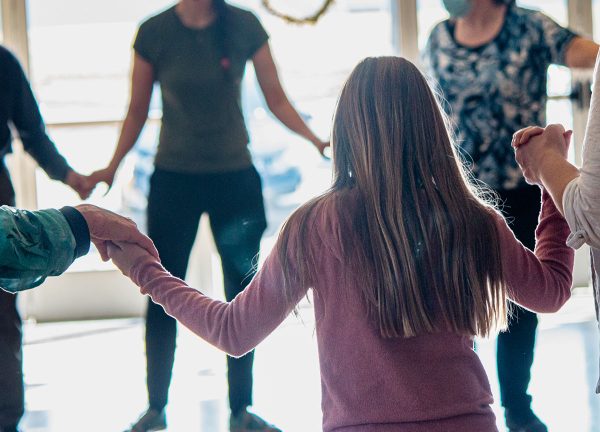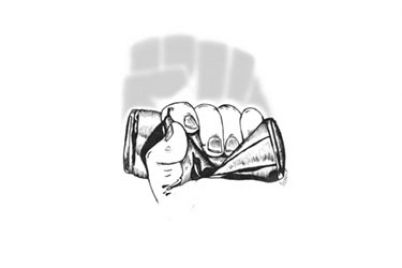
Dancers of all ages hold hands in a circle while learning new moves. Ruby Go | Washtenaw Voice
by Grace Crandall
Staff Writer
Tucked away off Concourse Drive in Ann Arbor lies a small studio with wood-paneled floors. Walking into the studio on a Sunday afternoon, a newcomer may not know what to expect. But whether it’s your first time or your 10th time, you will be welcomed by a group of people, ready to dance.
This is the international folk dance group that is part of the Ann Arbor Community for Traditional Music and Dance (AACTMAD). Come rain or shine, the group meets every other Sunday afternoon.
Drake Meadow, the group’s founder and leader, begins the meeting with an hour-long lesson, in which regulars and newcomers join together to learn new steps.
Barefoot and donned in vest and dress pants, Meadow welcomes the dancers, reminding them that it doesn’t matter how many times they have danced.
“We are in a circle, where no one’s in the front, and no one’s behind,” says Meadow.
He then starts the lesson with a slow “pravo,” meaning “easy” in Bulgarian. This step is the basis for many of the dances, in which dancers hold hands, travel, and switch feet in a quick, quick, slow, slow rhythm.
As the lesson continues, more people trickle in. Soon, the circle welcomes about 40 dancers, varied in age from teens to 70s. It may seem as though this group has been established for a while, but it began only this past December.
While the international folk dance group is new, AACTMAD has been an important part of the lives of Ann Arbor natives for years.
AACTMAD is a non-profit organization that hosts over 100 dance events every year. With over 200 members in Southeast Michigan, the foundation serves to introduce historical dance to an ever-growing community.
AACTMAD hosts many types of traditional dance events, from English country to swing. Meetings for the groups are scheduled at various times throughout the week. Suggested admission is given, but members are encouraged to pay what they can.
Meadow, 53, began his time with AACTMAD calling contra dances and English country dances. While he still calls these dances, Meadow recently realized his wish to start an international folk group within the community as well.
“(International folk) dance in Ann Arbor died out, and coming out of the pandemic, I really was missing this,” said Meadow.
International folk dance has been popular in the Ann Arbor area for many years. But as groups in the area slowly phased out, Meadow wished to revive the dance and traditions associated with Balkan nations.
Meadow approached AACTMAD with his idea, and several people quickly offered to help. In just a few months, the group was ready to begin teaching and leading traditional dances.
“I really didn’t know what was going to happen,” said Meadow. “We got a smaller venue for our first dance in December, and I thought, ‘Okay, we’ll get five or 10 people’…and it was about 40 that showed up, to the point that we were crowded in.”
From there, the group has only grown. They use a larger dance hall, and average about 45 people, new and returning, each meeting. The dancers usually learn new steps to recorded music, but the goal is to feature live music about once a month, said Meadow.
In late March, the group will welcome Veselba, a local trio that plays with traditional Bulgarian instruments. The band plays in the center of the circle, allowing dancers to better connect with the musicians.
This connection is something that makes international folk dance unique. Jean Borger, who helped launch and lead the group, attested to the community that dance provides.
“When we dance together there’s a sense of one and connection,” said Borger. “We have fun, but there’s also an incredible respect for the cultures.”
International folk dance celebrates dance from all over the world, but primarily focuses on the Balkan nations, such as Bulgaria, Romania, and Macedonia. Holding hands, dancers celebrate the steps and rhythms that have brought people together for centuries.
“I’m new to dancing,” said Maris Laporter, who has come to the past four meetings. “I was too shy to dance. Then I came here and saw I wasn’t worse than anybody else, and nobody was paying attention…I got over my self-consciousness and now I love it.”
It is the hope of the international folk dance community that dancers leave with a sense of connection. Meadow commented on the impact of mixing centuries-old dancing with ever-evolving interpretation.
“Sometimes, I will alter a dance slightly if it doesn’t work well for the people who are in front of me…they are the most important thing,” said Meadow. “These traditions are living, and they can serve us. So I serve these people through this tradition.”

